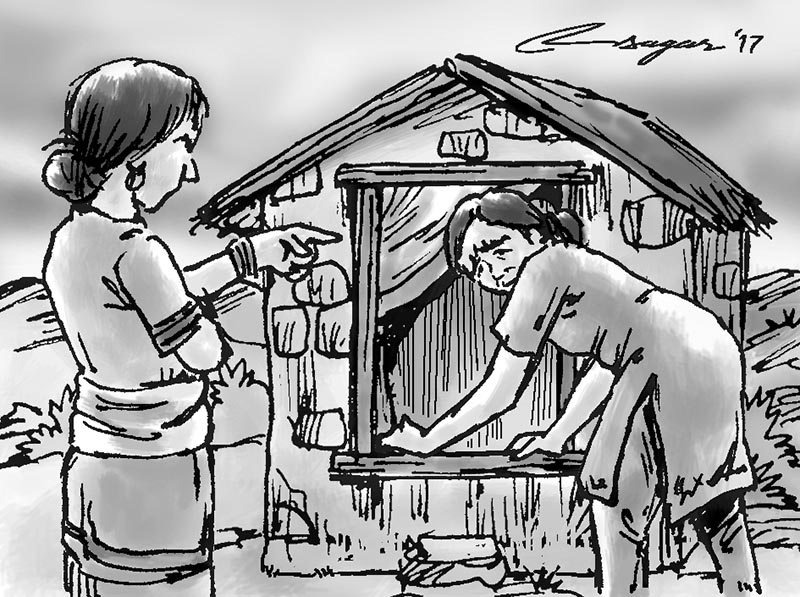Women’s issues: Laws to correct them
Police data show the region-wise crime against women and children for 2015-16 — human trafficking, polygamy, child marriage, rape, attempt to rape, unnatural sex, witchcraft related violence and domestic violence — continues unabated
Criminalizing the practice of sending women to Chhau huts is the next landmark after abolition of Sati. It was a long overdue move against one of the worst forms of discrimination against women, but it did happen eventually with the Parliament passing the criminal code bill. Apart from a number of laws provisioning more severe punishment for serious criminal offences, what stands out in the Criminal Offences (Punishment Determination and Implementation) Bill is the criminalization of the custom of Chhaupadi. Although this practice was outlawed a decade ago, communities in the far-western region of the country had continued to send girls and women to the Chhau hut away from their homes, excluding them from all normal activities every month when they bled or when they gave birth.
The mind-set in Bajura, Bajhang and parts of western Nepal saw both menstrual and the post-natal as defilement — ‘impure’, therefore, untouchable, leading to isolation, segregation and exclusion for women. Things as biological as a woman’s monthly cycle and child birth carried with them a baggage overflowing with a whole lot of ‘maleist’ funda working overdrive to establish patriarchal supremacy.
It is not that voices were not raised against Chhaupadi, it is also not that anti-Chhau drives were not launched. I/NGOs and rights activists had been doing their bit to pile pressure on the government. The engagement of international organizations, including the UN, is also a major factor that hastened the Criminal Offences Bill’s passage in the House.
Chhaupadi must die and its milder form still prevalent in urban settings — Nachhuni — must also fade away into oblivion with the changing time for these are demeaning, humiliating, unjust means of subjugation. They have lasted more than Sati, which was abolished almost 100 years ago by Rana Prime Minister Chandra Shamsher in 1920. After the horrific practice of burning the wife of the dead on the funeral pyre — Sati — was abolished, the criminalization of Chhaupadi must be seen as the next landmark in the long drawn-out process of ensuring the rightful place for women through elimination of injustice against them.
The government is also to blame. It outlawed Chhaupadi but did not follow up with appropriate legal measures. While law enforcement agencies could do nothing by way of action against the widely prevalent practice of Chhaupadi, the activities of the many I/NGOs were limited only to raising awareness against this custom.
However, with the passage of the Criminal Offences Bill that provisions three months imprisonment and a fine of 3,000 rupees for anyone involved in promoting the practice of Chhaupadi, the legal hurdle in punishing the perpetrators has been overcome and one can now expect the punishment to act as a deterrent.
The unquestioning adherence to a blind belief had become the norm, a way of life for almost the entire community. And, sadly, it must be said this was so mainly on account of collusion on the part of the womenfolk. Yes, the matriarch of the house, the mother hen, tutored her mentees — the daughters and her daughter-in-laws — on the need to maintain the way laid out by her male counterpart, the patriarch as they climb up the ladder of family hierarchy over time.
In Kathmandu, the Menses Blues is still sung outside the kitchen and the brand of Nachhuni still makes her an untouchable for exactly the same number of days as her female counterpart in Bajura. That’s Chhaupadi in the city. It’s more complex and the complexity of it has watered it down. Many factors come into play, but it is not a serious problem. No woman has died because of her periods in Kathmandu. There’s no space available for Chhau huts in cramped up Kathmandu, though the ‘touch-me-not’ five-days-a-month thing does happen here too, compliance or non-compliance is hardly an issue.
They observe it by keeping women away from social functions in the city, but women and newborns are not endangered. There’s less risk of infection and no risk at all of snakebites and possible attacks by wild animals as in the Chhau huts.
Police data show the region-wise crime against women and children for 2015-16 — human trafficking, polygamy, child marriage, rape, attempt to rape, unnatural sex, witchcraft related violence and domestic violence — continue unabated. Domestic violence is also on the rise. What is however most surprising about the figures with the police is that although the overall crime rate has dropped, social crime, especially crimes against women, including domestic violence, has gone up. There is an inherent contradiction between the way Nepali society presents women and the way it treats them.
On the one hand, women are idealized to the point of idolatry as we still regale in drawing upon the mythological figures of Sita, and Lakshmi and Durga and Kali; while on the other, insofar as ground reality is concerned, they are still sent to the Chhau hut and by and large, we are still a wife-beating society. For change to come men must understand women don’t need to be goddesses, nor do they need to submit to the bestiality of men. Women, like men are humans who love their right to live with dignity just as men do.
The author can be contacted at his email: Bjonjon@hotmail.com






